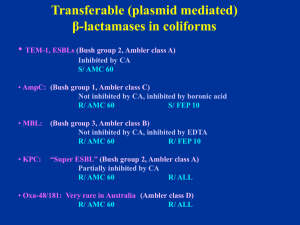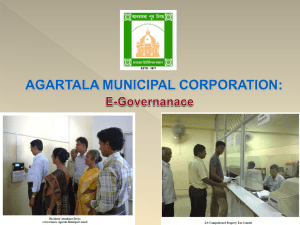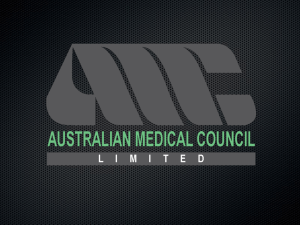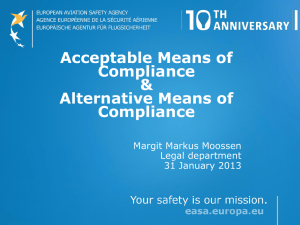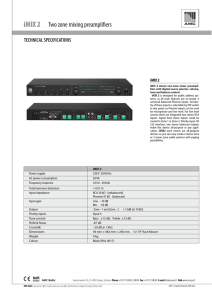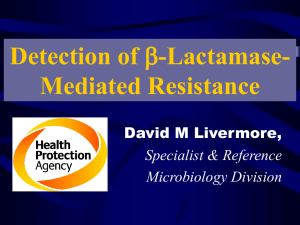see Power points 2011.
advertisement
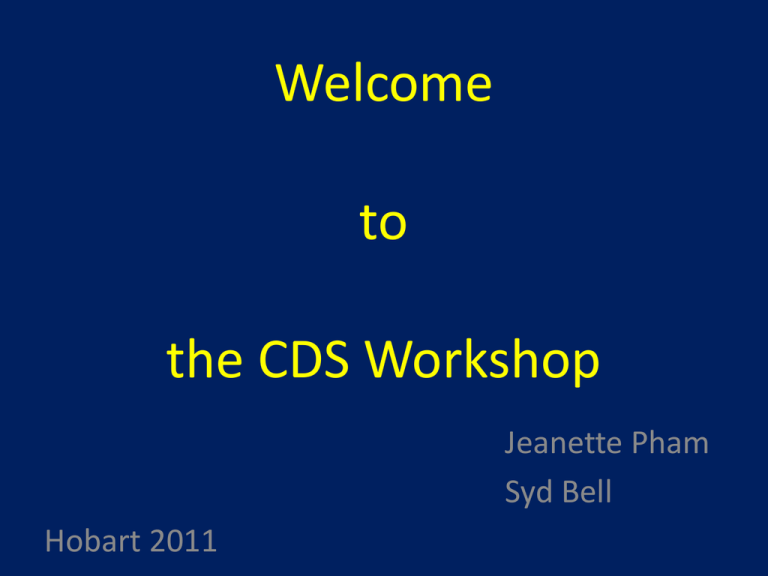
Welcome to the CDS Workshop Jeanette Pham Syd Bell Hobart 2011 VALE - Maria Yates 1954 - 2011 The Sixth Edition is Coming ! Help Needed ! If you have any suggestions on modifications or additions to the Manual Please email us at: cds@sesiahs.health.nsw.gov.au smbell@iinet.net.au Changed Cefotaxime/Ceftriaxone Testing for • Pneumococci (sites other than CSF) • Streptococcus “milleri” group (anginosus, constellatus & intermedius) Antibiotic/disc Cut-off (mm) Cefotaxime 0.5mg 4mm Ceftriaxone 0.5mg 4mm MIC(mg/L) 0.5 0.5 Susceptibility of “milleri” Group Streptococcus pyogenesStrep Streptococcus “milleri” Non multi-resistant MRSA = original CA-MRSA Resistant to penicillin (P 0.5) and cefoxitin (FOX 10) S/ erythromycin (E 5), tetracycline (TE 10), co-trimoxazole (SXT 25) and ciprofloxacin (CIP 2.5) and gentamicin (not shown). Recent isolates: R/ Ery, Cip. β –Lactamase negative NMR- MRSA Clear large zone around OX 1, light growth around P 0.5 and a small zone around FOX 10 => excellent inducer of PBP 2a. Report as resistant to methicillin and all other β-lactams. Staphylococus aureus v/s cefoxitin 10 Standard 6 mm cut off mecA gene negative: zone around 7 - 9 mm mecA gene positive: zone 0 - 5 mm * Rare strains have problem with expressing the resistance => zone around 6 mm * Repeat with higher inoculum or * Send for mecA gene PCR Enterococci Tested on blood Sensitest agar in 5% CO2 (high humidity in CO2 incubator enhances the growth) Ampicillin 5 µg (AMP 5, 4 mm) Gentamicin 200 µg (CN 200, high level resistance) Linezolid 10 µg (LZD 10) Nitrofurantoin 200 µg (F 200, urine, 4 mm) Quinupristin/Dalfopristin 15 µg (QD 15) (E. faecalis: naturally R/ QD) Streptomycin 300 µg (S 300, high level resistance, 4 mm) Teicoplanin 15 µg (TEC 15*) Tigecycline 15 µg (TGC 15) Vancomycin 5 µg (VA 5*) * Hazy edge with growth towards the discs Plate incubated in CO2: Vancomycin resistant Enterococcus faecium of VanB phenotype At 24 h, the reduced zone and the light growth towards the vancomycin disc (VA 5) is frequently observed with this phenotype. R/ VAN S/ TEC => vanB phenotype Plate incubated in Air: Same VR Enterococcus faecium of VanB phenotype At 24 h, the light growth towards the vancomycin disc (VA 5) is not obvious on the Sensitest agar plate incubated in air. The ß-lactamases of Gram-negative bacilli An update on the detection of common plasmid mediated β-lactamases in clinical isolates Common transferable (plasmid mediated) β-lactamases in coliforms • TEM-1, SHV-1, ESBLs (Bush group 2, Ambler class A) Inhibited by clavulanic acid (CA) S/ AMC 60 • AmpC: (Bush group 1, Ambler class C) Not inhibited by CA, inhibited by boronic acid R/ AMC 60 S/ FEP 10 • MBL: (Bush group 3, Ambler class B) Not inhibited by CA, inhibited by EDTA May have large zones R/ AMC 60 R/ FEP 10 • KPC: “Super ESBL” (Bush group 2, Ambler class A) Partially inhibited by CA R/ AMC 60 R/ ALL E. coli ACM 5186 (used in QC) producing TEM-1 Resistant to ampicillin (AMP 25) An E. coli producing an inhibitor resistant TEM (IRT) Resistant to ampicillin (AMP 25) and Augmentin (AMC 60) Susceptible to cephalexin (CL 100), imipenem (IPM 10), cefotaxime (CTX 5). Confirmation of IRT: R/ Augmentin (AMC 60), Timentin (TIM 85) and Tazocin (TZP 55) S/ cephalexin (CL 100), ceftazidime (CAZ 10) and cefotaxime (CTX 5). A typical Acinetobacter lwoffi (β-lactamase negative) S/ ALL A typical A. baumanii (or A. baumanii-like): High level of non inducible AmpC R/ ampicillin (AMP 5), cephalexin (CL 100), cefotaxime (CTX 5), cefepime (FEP 10), Augmentin (AMC 60) S/ imipenem (IPM 10) A strain of Acinetobacter sp.( Acinetobacter genomospecies 3) Low AmpC activity R/ CL 100 (cephalexin), AMP 25 zone > 6 mm with colonies at the edge Report: R/ ampicillin, cephalexin Cefotaxime is borderline (6mm) => R/S Enterobacteriaceae / Acinetobacter sp. Always test AMP 25 and CL 100 in parallel. (Cephalexin highly susceptible to AmpC hydrolysis) 1. S/ AMP 25, CL => S/ Ampicillin, amoxicillin, CL 2. R/ AMP 25, CL => R/ Ampicillin, amoxicillin, CL 3. R/ AMP; S/ CL 100 => R/ Ampicillin, amoxicillin S/ CL (TEM-1) 4. S/ AMP; R/ CL 100 => R/ Ampicillin, amoxicillin, CL (Low AmpC) (optional: confirm by nitrocefin testing) ESBLs (Ambler class A, Bush group 2) Inhibited by CA R/ S/ S/ Cephalosporins including cefepime (FEP) and aztreonam (ATM) Augmentin (AMC 60) Cephamycin (cefoxitin, cefotetan) CDS routine testing → Synergy with AMC 60 (no need for confirmation) S/ Imipenem (T) Disc positions recommended for urine isolates Klebsiella pneumoniae producing an ESBL in routine CDS test S/ Augmentin (AMC 60), typical synergy between Augmentin and cefotaxime (CTX 5) / cefepime (FEP 10) Report: S/ imipenem (IMP 10) Disc positions recommended for urine isolates Klebsiella pneumoniae producing an ESBL: synergy between Augmentin (ACM 60) and cefepime (FEP 10), no obvious synergy with cefotaxime (CTX 5) Probable intrinsic resistance and high ESBL activity. Disc positions recommended for urine isolates E. coli: No obvious synergy between Augmentin (AMC, borderline) and cefepime (FEP, 0 mm) or cefotaxime (CTX, 0 mm); probable high ESBL activity of ESBL and intrinsic resistance. S/ IMP (large zone, no resistant colonies) Detection of high activity ESBL or ESBL + intrinsic resistance Same E. coli: synergy between Augmentin (AMC) and aztreonam (ATM) placed in the centre, close to AMC disc. Need ATM to show synergy with AMC 60=> ESBL PM-AmpC in E. coli/ Klebsiella R/ AMC 60 (not inhibited by CA) R/ CL 100 S/ FEP 10 Standard interpretation (No resistant mutants) > 6 mm (no resistant col.) => S/ CTX 5 < 6 mm => R/ CTX 5 Confirmation (optional): inhibition by boronic acid (BA) (1-Benzothiophene-2-boronic acid) Routine CDS test showing an E. coli with a TEM-1 and a plasmid mediated AmpC R/ ampicillin (AMP) Augmentin (AMC), cephalexin (CL), cefotaxime (CTX) S/ cefepime (FEP 10) and imipenem (IPM 10). The same E. coli (PM-AmpC) Synergy between boronic acid discs (blank) and adjacent discs: cefotaxime (CTX 5), Augmentin (AMC 60), cephalexin (CL 100), ceftazidime (CAZ 10). Blank disc= 250 µg boronic acid disc S/ FEP, IMP Routine CDS test showing an E. coli with a TEM-1 and a LOW ACTIVITY plasmid mediated AmpC: AMP (0 mm), AMC (5 mm), CL (2 mm), CTX (7.5 mm), FEP (12 mm), IMP (12 mm). No resistant mutants in CTX zone. Report: R/ AMP, AMC, CL S/ CTX, FEP, IMP Routine CDS test showing an E. coli with an inducible PM AmpC/resistant mutants (very rare): R/ ampicillin (AMP), Augmentin (AMC 60), cephalexin (CL 100), cefotaxime (CTX 5) + resistant colonies in the zone. Report: S/ cefepime (FEP 10) and imipenem (IPM 10) CDS test showing an E. coli with an unusual PM AmpC from B/C Large zones around ampicillin (AMP 25, no TEM-1), Augmentin (AMC 60), cephalexin (CL 100), cefotaxime (CTX 5) + resistant colonies in the zones. S/ cefepime (FEP 10) and imipenem (IPM 10) with clear zone, no colonies. Report: S/ cefepime, imipenem Same E. coli: resistant colony in CTX zone R/ ampicillin (AMP), Augmentin (AMC 60), cephalexin (CL 100), cefotaxime (CTX 5) showing synergy with boronic acid (blank disc). Report: S/ cefepime, imipenem Acquired Metallo-Beta-Lactamases (MBLs) Ambler class B or Bush group 3 * Inhibited by EDTA (Zinc molecule) IMP-4 (most common) VIM, SPM, GIM, SIM (P. aeruginosa) NDM (new) * Hydrolyses all beta-lactam (except aztreonam) Enterobacteriaceae May have a zone > 6mm with IPM 10 Pseudomonas aeruginosa Highly resistant to all β-lactams => no zone S/ aztreonam E coli: R/AMP 25, AMC 60, CTX 5, CL100 and FEP 10, colonies at the edge of imipenem zone (> 6 mm). No synergy between FEP/AMC → not ESBL => ? MBL Resistant colonies at the edge of IPM 10 zone => ? MBL Simple phenotypic detection of MBL: Same isolate showing synergy between an EDTA (blank) discs placed next to cefotaxime (CTX)/ imipenem (IPM)/ cefepime (FEP)/ ertapenem (ETP) discs.. S/ ATM Klebsiella pmeumoniae: Synergy between EDTA (blank discs) and IPM 10/ETP 10 only R/ ATM and synergy with AMC 60 => MBL and ESBL Pseudomonas aeruginosa candidate for MBL detection: No zone around imipenem (IPM 10) ceftazidime (CAZ 10), tazocin (TZP 55), cefepime (FEP 10) and Timentin (TIM 85) S/ aztreonam (ATM 30) EDTA 415 EDTA 415 EDTA 415 The same Pseudomonas aeruginosa with EDTA Detection of MBL: Synergy between an EDTA disc placed next to imipenem (IPM 10)/ meropenem (MEM 5)/ ceftazidime (CAZ 10) discs. S/ aztreonam (ATM 30) Pseudomonas aeruginosa resistant to all β-lactams, imipenem (IPM 10) ceftazidime (CAZ 10), tazocin (TZP 55), cefepime (FEP 10) and Timentin (TIM 85) including aztreonam (ATM 30). ??? * Small zone around MEM 5, IPM 10 and ATM 30 EDTA 415 EDTA 415 EDTA 415 The same P. aeruginosa: Synergy between EDTA and ATM/TZP/CAZ/TIM and MEM 5 but not with IPM => Non specific synergy between EDTA and beta-lactams => not MBL K. pneumoniae: R/ Augmentin (AMC 60), cephalexin (CL100), cefotaxime (CTX 5), cefepime (FEP 10), imipenem (IPM 10) zone (> 6 mm). No synergy between EDTA and IPM 10 ??? The same K. pneumoniae: Synergy between AMC 60 and IPM 10 => inhibited by clavulanate ??? A β-lactamase of Ambler class A or Bush group 2 hydrolysing carbapenem => a KPC-2 producing K. pneumoniae from Greece KPC in Klebsiella pneumoniae Plasmid mediated K. pneumoniae carbapenemase (KPC) Ambler class A or Bush group 2f • Reported in Europe, US (Brooklyn 24%) • Australia (first isolate in Sept 2010) • Inhibited by clavulanic acid => ESBL affecting carbapenems KPC-1 , KPC-2,…KPC-4 High level resistance to FEP, CTX, CRO, CAZ, ATM, …. • Imipenem MIC ≥ 4 mg/L (border line) • Ertapenem MIC > 8 mg/L (resistant) • Inoculum dependent => broth MIC unreliable Summary: “Super” ESBL + R/IPM or colonies at edge of IPM zone In doubt, test ertapenem and/or send for confirmation New Table 10.4 A guide to the testing and reporting of β-lactam antibiotics for Gram-negative organisms. 1. EEC to replace ESCHAPM (Table 10.4) 2. Serratia marcescens (Table 10.4) 3. Aeromonas sp. (Table 10.4) 4. HPM: standard interpretation 5. K. oxytoca: standard interpretation 6. PM AmpC: standard interpretation
